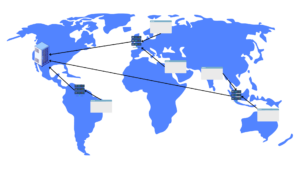Every day we see new businesses entering the online business world, making it crucial to deliver an engaging experience to visitors, or else, they’ll find a new website. Fast CDN is one of the best ways to optimize a website.
Content delivery networks are everywhere — and we don’t even realize it. From reading articles on websites, shopping from online stores, watching videos, or scrolling through social media – there’s CDN everywhere.
And without implementing the fastest CDN available, you cannot boost your website’s ranking and help search engines crawl it better. Let’s explore what a CDN can do for you.
Overview of fast CDN
A content delivery network, also known as a CDN, is a geographically distributed group of servers that presents content faster to end users. It also helps to quickly load website assets to the internet, including HTML pages, JavaScript files, images, and videos.
When a user visits a website, the data has to travel from the website’s server to the user’s computer. If that user is far away from the server, it’ll take time to load to the user’s computer. That’s where CDN, the answer to file overload, comes in and helps the data reach the end-user faster.
Importance of website speed
Website speed is how quickly a website loads and displays all the functional web pages. If a website performs slowly, it’ll affect all the items slowly, driving away the visitors. In contrast, if a website loads quickly, it’ll likely get more traffic and have better conversion rates.
Improved website speed also affects the bounce rate, which means users will bounce back from our website if it doesn’t open quickly and display the information they want to see.
What Is CDN?
A CDN is a mesh of interconnected servers spread in different geographical locations to speed up webpage loading for heavy-data applications.

It’s designed to solve the issue of latency, which is an annoying delay that occurs when a user requires to load a web page to the time it displays onscreen.
Fast CDN: Overview
Fast CDN takes the basic concept of CDN to the next level by ensuring that a website’s content distribution is evenly distributed across several servers in the CDN network.
It also focuses on proximity-based routing and also employs effective caching techniques that help to significantly reduce the time it takes to display content.
Benefits of using fast CDN
Let’s understand the benefits of using Fast CDN:
● Understanding the Benefits of Fast CDN for Website Speed
Increased website speed encourages visitors to stick around longer. Thus, a Fast CDN helps to achieve this motive by reducing bandwidth costs, reducing page load time, and increasing content availability as well as security.
A fast CDN implements effective caching and other optimizations that reduce the amount of data the origin server provides, which ultimately reduces the cost of hosting for website owners too.
Since slow speeds frustrate users, they tend to leave the website, showing how closely website speed and user experience are related. The website will get a lower ranking with low conversion rates and increased bounce rates. In contrast, a fast-loading page will keep users engaged, enhance their browsing experience, and increase the number of conversions.
● Understanding the benefits of fast CDN for user experience
User experience and user interface indicate how satisfied a user will be when they land on a website and find it easy to navigate.
A fast CDN helps to generate content quickly by reducing load time and ensuring that website performs consistently across all devices and locations.
Not only does this enhance the user experience, but it also translates to higher conversion rates as the user coming to the website will be more engaged. More visitors means better ranking, and better ranking equals boosted website traffic.
Setting Up Filestack’s Fast CDN for Your Website
Filestack CDN consists of multiple data centers called points of presence (PoPs). Each PoP has its own hosting and serving content to users.
- The first step is to set up your website’s DNS (Domain Name System) records.
- After setting up DNS records, you need to integrate Filestack as a CDN into your website. This can be done by using the provided SDKs (such as JS, Ruby, Python, Android, Swift, or PHP).
- Once the integration is complete, you can customize various settings according to your specific requirements. This includes configuring caching settings, domain and hosting settings, security settings, and more.
- It is important to thoroughly test the performance of your website after implementing Filestack’s Fast CDN. Monitor the website’s loading speed and overall performance to ensure that the CDN is improving website speed and delivering content efficiently.
- Regularly monitor and optimize the CDN performance by analyzing metrics and making necessary adjustments to maximize the benefits of Filestack’s Fast CDN for your website.
Understanding Filestack’s fast CDN
Filestack leverages a CDN that ensures fast and global access to your assets. We value your requirements and ensure that our CDN manages all the assets deployed on your website for easy and fast access.
It enables a website owner to:
- Improve customer engagement. Filestack’s solution optimizes images, audio, and video on the fly and delivers them faster through their CDN, improving page load times and conversions.
- Ensure reliable and Secure Delivery. Helps achieve optimized, high-speed delivery across multiple platforms and devices, confidently handling large files within your application.
- Deliver Files Faster. We use Fastly, the best CDN partner, which empowers every uploaded file through RESTful API and generates a CDN URL for rapid delivery.
How Filestack’s fast CDN works
We establish CDNs through points of presence (PoP) spread through different locations. Some of the steps involved include:
- Caching. Filestack caches multiple copies of the same data to enable faster data access. In the context of CDN, it means to process stored static website content on multiple servers.
- Dynamic acceleration. This process is for dynamic websites, unlike caching. CDN servers optimize the connection between themselves and the origin server, allowing for faster processing of dynamic requests. This eliminates network latency and the need for repeated security verifications, resulting in improved connection optimization through different features.
- Edge Logic computations. The CDN edge server helps perform logical computations to simplify the communication between the server and the client. For instance, it can inspect user requirements and modify caching behavior or handle incorrect user requests to enable logical computations.
The Impact of Filestack’s fast CDN on website speed
We know how important website speed is for the end-user and their engagement. How useful they find your website is directly proportional to the success of a website.
Filestack’s Fast CDN ensures to boost up a website by focusing on factors that are bound to give results. Not only does the CDN reduce latency, but it also improves the overall loading time by increasing bandwidth.
This ensures that the organic visitors coming to your website stay there, leading to lower bounce rates and increased user engagement.
Implementation of Filestack’s Fast CDN
With Filestack’s Fast CDN, you can integrate in just seconds. The coding language doesn’t matter, so you can easily implement Filestack in your applications. You can choose from our SDKs to get started. These include JS, Ruby, Python, Android, Swift, and PHP.
We also offer several customization options based on your requirements. You can toggle the caching setting, domain and hosting settings, security settings, and more according to your requirements.
After doing all the tweaking, it’s important to test how the website performs. Make these changes, and monitor how the CDN improves website speed and improves its performance.
How Filestack’s fast CDN improves SEO
Just like CDNs, a website’s SEO score also greatly impacts how the website will be ranked. Both of these are huge factors in optimizing page speed, thus having a direct relation to each other.
Think of CDNs as a method that helps improve the technical ranking factors for SEO. Let’s explore how this affects a website’s ranking in more detail.
It Reduces Load Time
Load time is the time taken by a website to fully display its content. It’s a significant factor that impacts user experience and SEO ranking.
Filestack’s Fast CDN reduces load times by accessing content from a server closer to the client. That means we fetch the content that is physically nearest to the user, which reduces the network latency and the time it takes for the content to load on the user’s device.
It Enhances Caching Capabilities
The reduced load time helps improve the caching algorithms and canonical headers to enhance the SEO ranking of a website by omitting duplicate content creation issues. Caching means storing copies of the website content in a “cache” – a temporary storage location that is closest to the user.
These algorithms also optimize the delivery of static content and reduce the loading time on the server. Static content includes CSS files, images, JS files, and other resources that do not need to be refreshed as frequently.
Helps with Indexing and Crawling for SEO
Different search engines have crawlers that index content on different websites and their pages. Fast CDN utilizes different caching algorithms to help with indexing and crawling processes.
So, when search engines come across a website using a Fast CDN, they can access it more effectively, which reduces server load.
These factors positively impact the indexing and crawling indexes for search engines, which ultimately helps improve the SEO score for a website.
Conclusion
Filestack’s Fast CDN is the one-stop CDN that ensures improved website speed, enhances SEO, and implements effective caching algorithms for static content and dynamic acceleration for dynamic content. It ensures to enhance the browser experience and content delivery across several devices and platforms.
CDNs continue to evolve as content and websites grow online. Filestack ensures to customize the CDN experience for all websites and ensures they see results in their website rankings.
